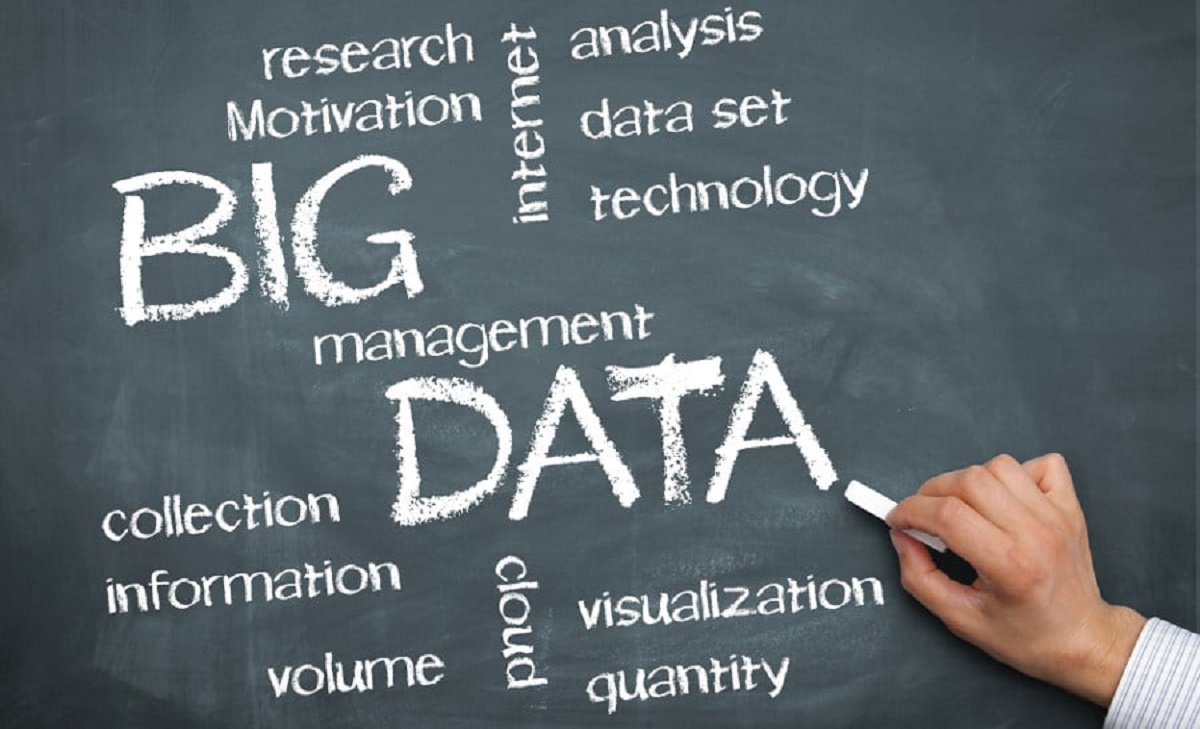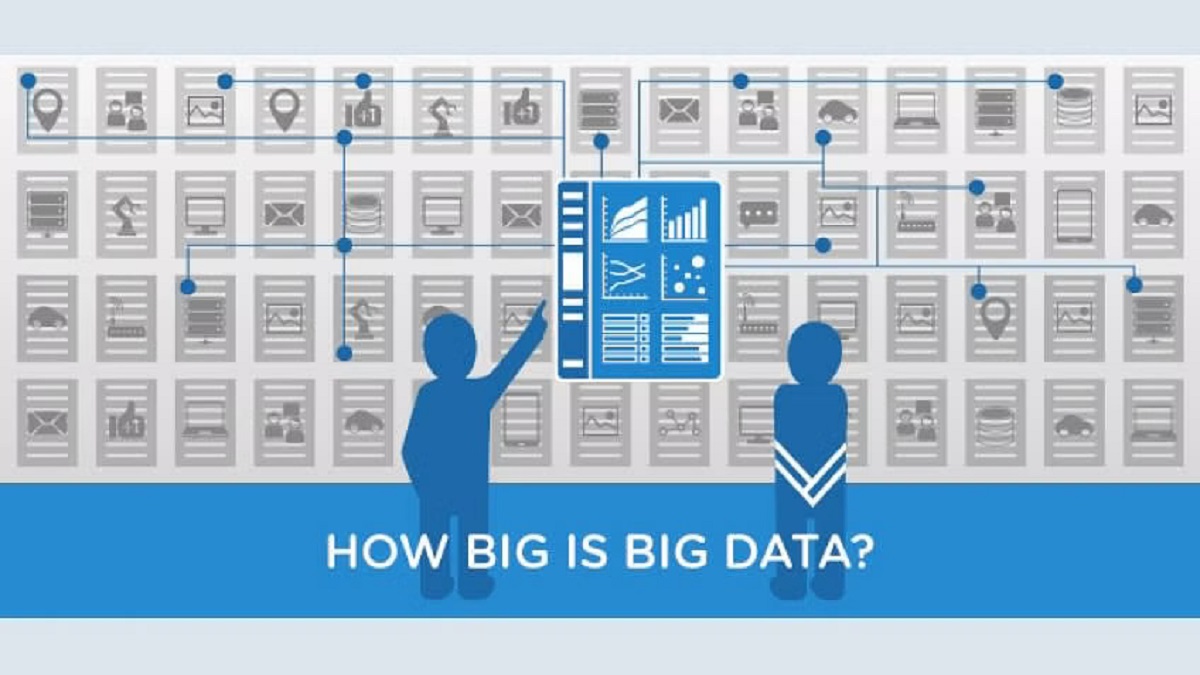Introduction
Big data has revolutionized the way businesses operate and make decisions in today’s digital age. With the vast amounts of data generated every day, organizations across various industries have found valuable insights that contribute to growth and innovation. From e-commerce and healthcare to government and media, big data is being used to drive efficiency, improve customer experiences, and unlock new opportunities.
As technology continues to advance, the ability to collect, analyze, and interpret large datasets becomes even more crucial. The utilization of big data allows companies to gain a competitive advantage by understanding customer behavior, optimizing operations, and making predictions based on patterns and trends. In this article, we will explore the diverse applications of big data across different sectors and industries.
E-commerce and Online Retail: The e-commerce industry heavily relies on big data to personalize recommendations, analyze purchase patterns, and optimize pricing strategies. Companies like Amazon and Alibaba leverage big data to offer relevant product suggestions and create dynamic pricing models, enhancing customer satisfaction and boosting sales.
Healthcare: Big data plays a vital role in healthcare, enabling analysis of patient records, medical imaging, genomics, and research data. It helps in diagnosing diseases, predicting outbreaks, developing personalized treatment plans, and improving patient outcomes. Big data analytics also plays a crucial role in drug discovery and research by facilitating large-scale data mining and analysis.
Financial Services: The financial industry relies on big data for fraud detection, risk assessment, and customer profiling. Analyzing large volumes of transactional data helps identify suspicious activities and patterns, minimizing financial risks. Big data also contributes to making data-driven investment decisions, developing customized financial products, and improving customer experiences through personalized services.
Information Technology and Telecommunications: Big data helps IT and telecommunications companies optimize network performance, assess customer behavior, and provide personalized services. Analyzing data from devices and networks enables proactive network management, efficient resource allocation, and predictive maintenance. It also fuels innovation in areas like Internet of Things (IoT), 5G network optimization, and cybersecurity.
Manufacturing and Supply Chain Management: Big data aids in optimizing manufacturing processes, predicting maintenance needs, and improving supply chain efficiency. By analyzing real-time production data, companies can identify bottlenecks, reduce downtime, and enhance product quality. Supply chain analytics enables better demand forecasting, inventory management, and logistics planning, leading to cost savings and increased customer satisfaction.
E-commerce and Online Retail
The e-commerce industry has experienced significant growth in recent years, and big data has played a crucial role in its success. By harnessing the power of data, companies in this sector can provide personalized experiences, optimize pricing strategies, and gain insights into customer behavior.
One of the key applications of big data in e-commerce is personalized recommendations. Companies like Amazon and Alibaba use sophisticated algorithms to analyze customer browsing and purchase history to offer relevant product suggestions. This not only enhances the shopping experience for customers but also increases the likelihood of cross-selling and upselling, leading to higher sales and customer satisfaction.
Big data is also utilized in dynamic pricing, which involves adjusting prices in real-time based on various factors such as demand, inventory levels, and competitor pricing. By analyzing large volumes of data, e-commerce companies can optimize pricing strategies to maximize revenue and maintain a competitive edge.
Inventory management is another area where big data plays a significant role. By analyzing historical sales data, current demand, and other variables, companies can accurately forecast demand and optimize inventory levels. This helps in minimizing stockouts, reducing carrying costs, and improving overall supply chain efficiency.
In addition to these applications, big data also enables e-commerce companies to gain insights into customer behavior and preferences. Analyzing data from various touchpoints such as website interactions, social media, and customer reviews allows companies to understand their customers better. This information can be used to tailor marketing campaigns, improve product offerings, and enhance the overall customer experience.
Furthermore, big data helps e-commerce companies identify patterns and trends in customer buying behavior. This allows them to anticipate market trends and adjust their strategies accordingly. For example, by analyzing data from previous holiday seasons, companies can predict peak buyer periods and optimize their marketing and inventory management strategies to meet increased demand.
Healthcare
The healthcare industry has seen a significant transformation with the advent of big data. The availability of large and diverse datasets has opened up new possibilities for improving patient care, diagnosing diseases, and conducting medical research.
One of the primary applications of big data in healthcare is in the analysis of patient records. By leveraging electronic health records (EHRs) and other healthcare data sources, healthcare providers can gain valuable insights into patient history, treatment outcomes, and population health trends. This data-driven approach enables clinicians to make more informed decisions, personalize treatment plans, and improve patient outcomes.
Big data is also instrumental in diagnosing diseases and predicting outbreaks. By analyzing vast amounts of medical and epidemiological data, algorithms can identify patterns and correlations that aid in early detection and prevention. For example, analyzing symptoms, demographic information, and geographic data can help identify potential disease hotspots and enable timely interventions.
Furthermore, big data fuels medical research and drug discovery. Researchers can analyze large-scale genomic data, clinical trial results, and real-world patient data to identify biomarkers, understand disease mechanisms, and develop targeted therapies. This accelerates the discovery and development of new treatments, ultimately benefiting patients and advancing medical science.
Another area where big data is making an impact is in personalized medicine. By analyzing the genetic profiles of individuals, along with other medical and lifestyle data, healthcare providers can tailor treatment plans to each patient’s specific needs. This enables more precise diagnosis, better management of chronic conditions, and the ability to predict and prevent diseases before they manifest.
Moreover, big data analytics plays a crucial role in healthcare fraud detection and prevention. By analyzing vast amounts of data, algorithms can identify patterns of fraudulent activities, such as suspicious billing or prescribing practices. This helps healthcare organizations and insurance providers combat fraud, reduce costs, and ensure that resources are allocated appropriately.
Overall, big data has the potential to revolutionize healthcare by enabling data-driven decision-making, improving patient care, and driving innovation in medical research and treatment approaches.
Financial Services
The financial services industry has undergone a significant transformation with the adoption of big data analytics. The ability to collect, process, and analyze vast amounts of data has revolutionized the way financial institutions operate, manage risks, and serve their customers.
One of the key applications of big data in financial services is fraud detection. By analyzing transactional data, customer behavior patterns, and other relevant information, algorithms can identify potential fraudulent activities in real-time. This helps financial institutions minimize risks, protect customers’ assets, and maintain the integrity of their operations.
Furthermore, big data analytics enables better risk assessment and management. By analyzing diverse data sources, such as market data, economic indicators, and customer information, financial institutions can make more informed decisions about lending, investments, and insurance underwriting. This leads to improved risk mitigation and more accurate pricing of financial products.
Big data also plays a vital role in customer profiling and personalized marketing. By analyzing data from various touchpoints, such as transaction history, browsing behavior, and demographic information, financial institutions can segment their customer base and offer tailored products and services. This enhances customer experiences, increases customer loyalty, and drives revenue growth.
Moreover, big data analytics contributes to data-driven investment decisions. By analyzing vast amounts of market and financial data, algorithms can identify trends, predict stock price movements, and uncover investment opportunities. This helps portfolio managers and investment advisors make more informed decisions, resulting in better investment performance for their clients.
Another area where big data is transforming the financial services industry is in regulatory compliance. Financial institutions are subject to a myriad of regulations, and compliance can be a complex and resource-intensive process. Big data analytics helps in automating compliance processes, monitoring transactions for suspicious activities, and generating accurate reports to regulatory authorities.
Additionally, big data is driving innovation in the financial technology (fintech) sector. Startups and technology companies are leveraging big data analytics to provide innovative financial services such as peer-to-peer lending, robo-advisory, and digital payment solutions. These fintech companies use big data to streamline operations, provide personalized experiences, and disrupt traditional financial services.
Overall, big data analytics is revolutionizing the financial services industry by enabling better risk management, personalized customer experiences, data-driven decision-making, and promoting innovation in fintech.
Information Technology and Telecommunications
The information technology (IT) and telecommunications industries heavily rely on big data to optimize operations, improve customer experiences, and drive innovation. With the proliferation of devices, networks, and digital services, the amount of data generated within these industries is immense, creating both opportunities and challenges that can be addressed through big data analytics.
One of the key applications of big data in IT and telecommunications is in network performance optimization. By analyzing network data, such as traffic patterns, latency, and bandwidth utilization, organizations can identify and address bottlenecks, optimize network configurations, and ensure a seamless user experience. Real-time analytics also allows for proactive network management, predicting and preventing potential issues before they impact users.
Big data analytics also plays a crucial role in assessing customer behavior and providing personalized services. By analyzing customer data, such as browsing history, preferences, and usage patterns, companies can deliver tailored offers, recommendations, and promotions. This level of personalization enhances customer satisfaction, drives customer loyalty, and increases revenue through upselling and cross-selling opportunities.
Moreover, big data contributes to the security and cybersecurity efforts within the IT and telecommunications industries. By analyzing large volumes of data from various sources, algorithms can detect and respond to potential threats, such as malware, hacking attempts, or phishing attacks. This enables organizations to proactively protect their systems, networks, and sensitive data, ensuring the integrity and confidentiality of their operations.
In addition, big data fuels innovation in areas such as the Internet of Things (IoT) and 5G network optimization. With the increasing number of interconnected devices and the growing demand for high-speed connectivity, big data analytics helps organizations manage the massive influx of data generated by IoT devices. It also enables organizations to optimize network performance, allocate resources efficiently, and provide reliable connectivity with 5G technologies.
Furthermore, big data analytics contributes to the development of new technologies and services. By analyzing data from various sources, including customer feedback, usage patterns, and market trends, organizations can identify emerging needs and develop innovative solutions. This drives product and service innovation, ensuring that organizations stay competitive in the rapidly evolving IT and telecommunications landscape.
Overall, big data analytics has become a cornerstone in the IT and telecommunications industries, enabling organizations to optimize operations, enhance customer experiences, drive innovation, and address the challenges brought about by the rapidly increasing volumes of data.
Manufacturing and Supply Chain Management
Big data has brought about significant advancements in the field of manufacturing and supply chain management. By harnessing the power of data, organizations in this sector can optimize production processes, improve quality control, and enhance overall supply chain efficiency.
One of the key applications of big data in manufacturing is in optimizing production processes. By collecting and analyzing real-time data from sensors and machines on the shop floor, organizations can identify inefficiencies, reduce downtime, and improve overall productivity. This data-driven approach allows manufacturers to make data-backed decisions, implement process improvements, and enhance operational efficiency.
Big data also plays a crucial role in predictive maintenance. By analyzing data from machine sensors, historical maintenance records, and other relevant sources, organizations can identify patterns and predict when equipment is likely to fail. This enables proactive maintenance, minimizing unplanned downtime and avoiding costly repairs. Overall, predictive maintenance helps organizations achieve higher equipment uptime, reduce maintenance costs, and improve operational reliability.
Supply chain management is another area where big data analytics is revolutionizing the manufacturing industry. By analyzing supply chain data, including demand forecasts, inventory levels, and transportation data, organizations can optimize inventory management, reduce stockouts, and streamline logistics operations. Big data analytics enables better demand forecasting, accurate inventory replenishment, and efficient transportation planning, leading to cost savings and improved customer satisfaction.
Quality control is also enhanced through the utilization of big data. By analyzing production data, inspection results, and customer feedback, organizations can identify product defects, trace their root causes, and implement corrective actions. Real-time quality monitoring allows for early detection and prevention of quality issues, ensuring that only products that meet the highest standards reach the hands of customers.
Furthermore, big data analytics helps organizations in tracking and improving supplier performance. By analyzing supplier data, including delivery time, product quality, and compliance with regulatory standards, organizations can identify underperforming suppliers, negotiate better contracts, and mitigate supply chain risks. This promotes efficient supplier relationship management and strengthens the overall supply chain network.
Additionally, big data analytics enables organizations to make data-driven decisions regarding product design and innovation. By analyzing customer feedback, market trends, and product usage data, organizations can identify areas of improvement, anticipate customer needs, and develop innovative products. This promotes competitive advantage and helps manufacturers stay ahead in the rapidly evolving market.
In summary, big data analytics is transforming the manufacturing and supply chain management sector by optimizing production processes, enabling predictive maintenance, enhancing supply chain efficiency, improving quality control, and driving innovation.
Transportation and Logistics
The transportation and logistics industry is highly dependent on efficient operations, timely deliveries, and optimal resource utilization. Big data analytics has emerged as a game-changer in this industry, providing valuable insights that enable organizations to streamline operations, improve customer satisfaction, and enhance overall supply chain performance.
One of the primary applications of big data in transportation and logistics is in route optimization. By analyzing real-time data on traffic conditions, weather patterns, and historical transportation data, organizations can identify the most efficient routes for their vehicles. This minimizes fuel consumption, reduces delivery times, and optimizes resource allocation, leading to cost savings and improved service levels.
Big data analytics also plays a critical role in predictive maintenance for transportation fleets. By analyzing sensor data from vehicles, historical maintenance records, and other relevant information, organizations can predict maintenance needs, identify potential issues, and schedule repairs proactively. This minimizes downtime, reduces repair costs, and ensures that vehicles are in optimal condition for transportation operations.
In addition to route optimization and predictive maintenance, big data contributes to better demand forecasting and inventory management in the transportation and logistics industry. By analyzing historical transportation demand, customer orders, and market trends, organizations can accurately anticipate demand patterns, optimize inventory levels, and ensure product availability at the right time and in the right location. This prevents stockouts, reduces excess inventory, and enables optimal utilization of transportation resources.
Furthermore, big data analytics enables better visibility and tracking in the transportation and logistics industry. By integrating data from various sources, such as GPS trackers, RFID tags, and warehouse management systems, organizations can monitor the movement of goods throughout the supply chain. Real-time visibility allows for proactive issue resolution, improves delivery accuracy, and enhances overall customer satisfaction.
Big data is also transforming last-mile delivery operations. By leveraging data on customer preferences, order histories, and specific delivery requirements, organizations can optimize delivery routes, schedule deliveries more efficiently, and offer personalized delivery options. This enhances the customer experience, increases delivery speed, and reduces operational costs associated with last-mile logistics.
Moreover, big data analytics helps organizations in the transportation and logistics industry to identify areas of optimization and improve the overall operational efficiency. By analyzing data from disparate sources, such as fuel consumption, vehicle performance, and driver behavior, organizations can identify inefficiencies, implement process improvements, and optimize resource utilization. This leads to cost savings, reduced environmental impact, and enhanced operational performance.
In summary, big data analytics is revolutionizing the transportation and logistics industry by optimizing route planning, enabling predictive maintenance, improving demand forecasting and inventory management, enhancing visibility and tracking, transforming last-mile delivery operations, and overall improving operational efficiency.
Energy and Utilities
The energy and utilities industry is undergoing a transformative shift with the integration of big data analytics. By leveraging the power of data, organizations within this sector can optimize energy generation, enhance grid management, improve resource efficiency, and provide better services to customers.
One of the key applications of big data in the energy and utilities industry is in optimizing energy generation and distribution. By analyzing data from smart meters, sensors, and other sources, organizations can gain insights into energy consumption patterns, peak demand periods, and load fluctuations. This allows them to adjust energy generation and distribution accordingly, ensuring a stable and efficient supply of electricity and reducing wastage.
Furthermore, big data analytics enables more effective grid management. By analyzing data from sensors installed throughout the grid, organizations can monitor power quality, detect faults, and respond to disruptions in real-time. This improves grid reliability, reduces downtime, and enhances the overall performance of the power system.
Big data also plays a crucial role in promoting energy efficiency and sustainability. By analyzing data on energy consumption, organizations can identify opportunities for energy conservation, implement energy-saving initiatives, and reduce carbon footprints. In addition, big data analytics can help in optimizing resource allocation, such as efficiently managing renewable energy sources, optimizing energy storage systems, and making data-driven decisions for infrastructure improvements.
Moreover, big data analytics enables organizations to offer more personalized services to customers. By analyzing customer energy usage patterns, organizations can provide tailored recommendations for energy conservation, offer incentives for efficient energy usage, and provide real-time feedback on consumption. This helps customers make informed decisions about their energy usage and leads to long-term energy savings.
In the utility sector, big data analytics contributes to predictive maintenance. By analyzing data from sensors installed in utility infrastructure, organizations can predict potential equipment failures, schedule maintenance proactively, and avoid costly unplanned outages. Predictive maintenance reduces downtime, increases asset reliability, and improves customer satisfaction by ensuring a continuous and reliable flow of utility services.
Furthermore, big data analytics helps organizations within the energy and utilities industry in compliance with regulations and guidelines. Monitoring and analyzing data related to emissions, environmental impact, and regulatory requirements enables organizations to ensure compliance and take proactive measures to maintain sustainability in their operations.
In summary, big data analytics is revolutionizing the energy and utilities industry, enabling optimization of energy generation and distribution, enhancing grid management, promoting energy efficiency and sustainability, providing personalized services to customers, enabling predictive maintenance, and facilitating compliance with regulations.
Government and Public Sector
The government and public sector are increasingly leveraging big data analytics to enhance service delivery, improve decision-making, and address complex societal challenges. The adoption of big data has the potential to revolutionize governance, economy, and public services by providing valuable insights and enabling evidence-based decision-making.
One of the key applications of big data in the government and public sector is in improving public service delivery. By analyzing data from various sources, such as citizen feedback, operational data, and demographic information, governments can identify areas for improvement, streamline processes, and enhance service quality. This data-driven approach enables the efficient allocation of resources and the delivery of services that align with citizens’ needs.
Big data analytics also plays a vital role in tackling complex societal challenges. By aggregating and analyzing data from multiple sources, such as social media, public health records, and weather data, governments can gain insights into the needs of their citizens and identify trends or issues that require attention. This enables proactive decision-making, better resource allocation, and more effective policy implementation.
Moreover, big data analytics contributes to improving public safety and security. By analyzing data from surveillance systems, social media, and public records, governments can detect patterns, identify potential threats, and respond swiftly to mitigate risks. This data-driven approach enhances emergency response capabilities, optimizes resource allocation for law enforcement, and promotes public safety.
Big data analytics is also used in urban planning and infrastructure development. By analyzing data on population density, transportation patterns, and environmental factors, governments can make informed decisions about urban development, transportation planning, and resource allocation. This leads to more sustainable and efficient cities, improved infrastructure, and better quality of life for citizens.
In addition, big data analytics contributes to improving government transparency and accountability. By analyzing data on government spending, contracts, and program outcomes, governments can detect instances of fraud, waste, and corruption. This helps in ensuring the proper use of public funds, enhancing governance, and building trust between the government and its citizens.
Furthermore, big data analytics enables evidence-based policy-making. By analyzing large and diverse datasets, governments can evaluate the effectiveness of existing policies, assess their impact, and make data-driven decisions when formulating new policies. This results in more targeted and efficient policies that address societal challenges and promote sustainable development.
Overall, big data analytics is transforming the government and public sector by improving public service delivery, enhancing decision-making, addressing societal challenges, promoting public safety and security, facilitating urban planning, ensuring transparency and accountability, and enabling evidence-based policy-making.
Media and Entertainment
The media and entertainment industry has undergone a significant transformation with the advent of big data analytics. With the proliferation of digital content consumption and the availability of vast amounts of user data, organizations in this sector can leverage big data to drive content creation, personalize experiences, optimize marketing strategies, and make data-driven decisions.
One of the key applications of big data in the media and entertainment industry is in content recommendation and personalization. By analyzing user data, such as viewing habits, preferences, and social media interactions, organizations can provide personalized content recommendations to their viewers. This results in a more engaging and tailored user experience, increases viewership, and improves customer retention.
Big data analytics also plays a crucial role in content creation and production. By analyzing audience data, organizations can gain insights into viewer preferences, content trends, and market demand. This helps content creators and production studios develop and produce content that resonates with their target audience, increasing the chances of success and attracting a larger viewer base.
Furthermore, big data analytics enables organizations in the media and entertainment industry to optimize marketing strategies. By analyzing data on viewer demographics, behavior patterns, and engagement metrics, organizations can segment their audience, target specific customer segments, and create personalized marketing campaigns. This not only enhances the effectiveness of marketing efforts but also helps in optimizing ad placements and improving the return on investment for advertisers.
Big data also contributes to rights management and content distribution in the media and entertainment industry. By analyzing data on licensing agreements, content availability, and viewer preferences, organizations can optimize content distribution strategies, negotiate appropriate licensing deals, and ensure that content reaches the right audience at the right time and through the right channels.
Moreover, big data analytics enables organizations to measure content performance and audience engagement. By analyzing data on viewership, content ratings, social media discussions, and user feedback, organizations can assess content popularity, identify trends, and evaluate the success of their content offerings. This data-driven approach helps in making informed decisions about content renewal, cancellations, and future programming directions.
In addition, big data analytics aids in combating piracy and copyright infringement in the media and entertainment industry. By monitoring online platforms, analyzing user behavior, and leveraging data algorithms, organizations can identify unauthorized distribution of copyrighted content and take appropriate actions to protect their intellectual property rights.
Overall, big data analytics has transformed the media and entertainment industry by enabling content personalization, optimizing marketing strategies, improving content creation and distribution, measuring audience engagement, and safeguarding intellectual property rights.
Social Media and Online Advertising
Social media platforms and online advertising have become an integral part of the marketing landscape, and big data analytics plays a significant role in maximizing their effectiveness. By analyzing vast amounts of user-generated data, organizations can gain valuable insights to target specific audiences, optimize advertising campaigns, and drive engagement on social media platforms.
One of the key applications of big data in social media is audience segmentation and targeting. By analyzing user data, such as demographics, interests, and online behavior, organizations can create highly targeted advertising campaigns. This allows them to reach the right audience with the right message, increasing the chances of conversion and maximizing return on investment.
Big data analytics also plays a crucial role in measuring and optimizing advertising campaigns on social media platforms. By analyzing engagement metrics, click-through rates, and conversion data, organizations can evaluate the performance of their ads in real-time. This enables them to make data-driven decisions, optimize ad strategies, and allocate resources more effectively to achieve the desired marketing objectives.
Furthermore, big data enables organizations to analyze the sentiment and behavior of social media users towards their brand and competitors. By monitoring social media discussions, analyzing sentiment analysis, and tracking brand mentions, organizations can gain insights into customer perception and sentiment. This allows them to respond promptly to customer feedback, manage brand reputation, and identify opportunities for improvement.
Big data analytics also contributes to influencer marketing strategies on social media. By analyzing data on audience demographics, engagement metrics, and influencer reach, organizations can identify influencers who align with their brand values and have a strong impact on their target audience. This enables organizations to collaborate with relevant influencers, amplify their brand message, and reach a wider audience.
Moreover, big data analytics helps organizations to identify emerging trends and topics on social media. By analyzing data on hashtags, user interactions, and content sharing patterns, organizations can understand what is trending among their target audience. This enables them to create timely and relevant content, participate in relevant conversations, and stay ahead in a dynamic and ever-changing social media landscape.
Additionally, big data analytics aids organizations in understanding customer preferences and optimizing user experiences on social media platforms. By analyzing user data, such as browsing behavior, clickstream data, and content interactions, organizations can personalize user experiences, offer relevant recommendations, and improve overall engagement. This leads to increased user satisfaction, improved customer loyalty, and higher retention rates.
In summary, big data analytics has transformed social media and online advertising by enabling audience segmentation and targeting, optimizing advertising campaigns, monitoring brand sentiment, identifying influencers, tracking emerging trends, personalizing user experiences, and maximizing the effectiveness of social media marketing strategies.
Conclusion
Big data has made a significant impact across various industries, revolutionizing the way organizations operate, make decisions, and serve their customers. From e-commerce and healthcare to government and media, the applications of big data are vast and diverse.
In the e-commerce sector, big data is used to personalize recommendations, optimize pricing strategies, and enhance customer experiences. It enables businesses to understand customer behavior and make data-driven decisions to drive sales and customer satisfaction.
The healthcare industry leverages big data for diagnosing diseases, predicting outbreaks, and improving patient outcomes. It plays a vital role in drug discovery, personalized medicine, and fraud detection, contributing to advancements in medical research and patient care.
In the financial services sector, big data analytics helps with fraud detection, risk assessment, and customer profiling. It enables data-driven investment decisions and personalized financial services, promoting better financial management and customer experiences.
The technology and telecommunications industry benefits from big data by optimizing network performance, analyzing customer behavior, and providing personalized services. It aids in IT infrastructure management, network optimization, and cybersecurity.
The manufacturing and supply chain management sector uses big data for optimizing production processes, improving supply chain efficiency, and enhancing quality control. It aids in demand forecasting, inventory management, and resource allocation, resulting in cost savings and improved customer satisfaction.
The transportation and logistics industry leverages big data for route optimization, predictive maintenance, and improving overall supply chain efficiency. It enhances delivery speed, reduces downtime, and improves resource allocation, leading to cost savings and improved customer service.
In the energy and utilities industry, big data is used for optimizing energy generation, improving grid management, and promoting energy efficiency. It helps in resource allocation, sustainable planning, and efficient usage of energy resources.
In the government and public sector, big data analytics enhances service delivery, improves decision-making, and promotes transparency and accountability. It aids in evidence-based policy-making, public safety management, and addressing complex societal challenges.
The media and entertainment industry benefits from big data analytics by enabling content personalization, optimizing advertising strategies, and measuring audience engagement. It aids in content creation, distribution, and safeguarding intellectual property rights.
Lastly, the use of big data analytics in social media and online advertising enables precise audience targeting, optimization of advertising campaigns, and enhancing user experiences. It empowers organizations to connect with their target audience, amplify brand messages, and make data-driven marketing decisions.
Overall, big data has transformed industries by providing valuable insights, optimizing operations, and driving innovation. Embracing big data analytics enables organizations to adapt to the changing business landscape, gain a competitive edge, and deliver enhanced products and services to meet the ever-evolving needs of consumers.

























